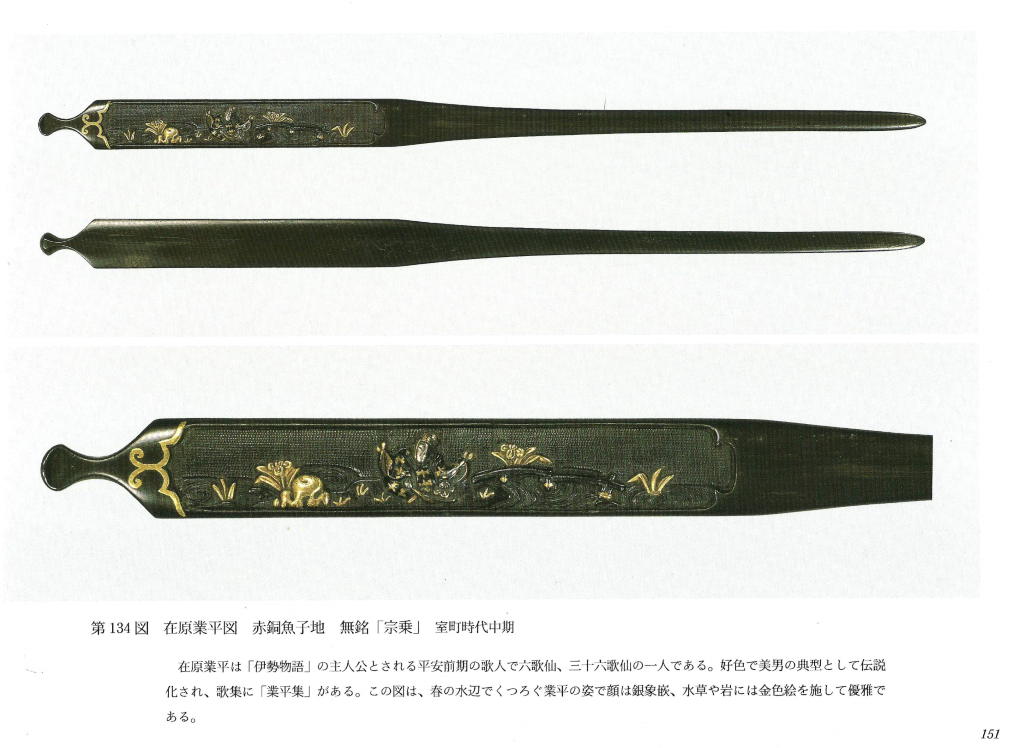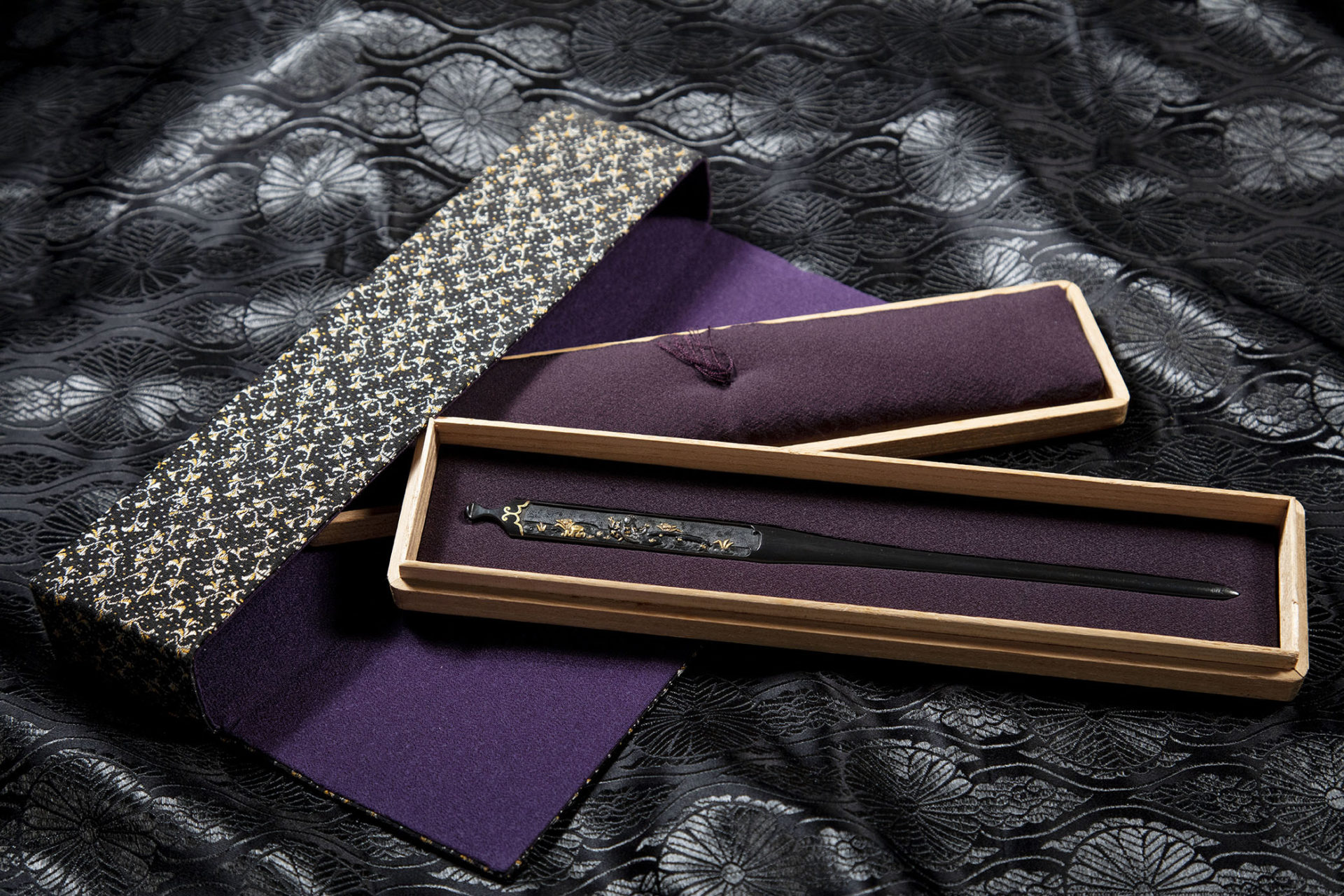An Important and Rare Joint Work of Goto Joshin and Goto Kojo
Third and Fourth Mainline Goto Masters
Among the many schools of fittings makers throughout Japanese history, the Goto school dominant in their longevity and success. Sixteen generations of mainline masters descended from the first generation, Goto Yujo, who worked for Ashikaga Yoshimasa about one hundred fifty years before the unification of Japan under the Tokugawa Shogunate. Successive generations of Goto makers sustained and improved the quality and workmanship and became the foundation for other great artists. Fittings made by Goto masters were especially precious and sets such as Mitokoromono (kogai, kozuka, and menuki, en suite) were used as exchanges of gifts to and between Daimyo and those of lofty social classes. Those with the means sought to build an entire set consisting of items from each Goto generation, a practice which continues to this day by enthusiastic collectors. Truly, this was an early example of the phrase “collect the whole set”. Because they were court artisans, the first four generations of mainline Goto makers did not sign their works. The importance of owning specific works brought many owners of items to bring pieces to later generation Goto masters for authentication, and on many works one can see the testimony of later generation’s attribution of a particular piece to a particular master. Of the seventeen generations of mainline Goto masters from 1440 to 1879, the first three generations are known as “Ko-Goto” or “Old Goto”, and consisted of Yujo, Sojo, and Joshin.
Joshin’s work was born in the fury of the “age of battles” when the provinces of Japan were at continuous war. Although he excelled in the designs that all Goto traditionally made such as Dragons and Shishi, he favored powerful symbolic subjects such as Tigers as well. Joshin was a Samurai Henri Joly wrote of him “well known as a doughty soldier”. Naturally as can be imagined from his turbulent surroundings, many of the works he created reflect his military influences with renderings of canteens or equestrian tack such as bits and bridles, stirrups, and the like. By comparison to the average lifespan of the various Goto masters, Joshin died relatively young at the age of about 51 years old in 1562. Considering that this would have provided him with only about 30 years of individual works as a part time maker with a larger outside occupation, his yield would be fewer in number when held to other longer-lived masters of 70 to 80 years. For this reason, in addition to his skill and individual style, his works are highly sought.
Goto Kojo was the son of Joshin, born in 1529 and lived a very long life of 92 years. Undoubtedly, he spent a great deal of time working with his father and was for a least the latter part of his life, probably not under the same threat of perishing in battle as his father had in 1562. His style is regarded as being more detailed than his father. Kojo worked directly for Oda Nobunaga, and then eventually Toyotomi Hideyoshi after Nobunaga was assassinated by Akechi Mitsuhide. Kojo was tasked with operating the national mint by Nobunaga and then also Hideyoshi. Kojo’s son and fifth main-line Goto master, Tokujo, would continue to manage it under Tokugawa Ieyasu. Kojo was a witness to some of Japan’s most turbulent times, its most historic transitions and events, and ascended from in-house craftsman to a figure of national importance and significance. He lived to see Japan from violent and uncertain total civil war, and then the entrance of Japan’s longest lasting period of peace and prosperity of over 250 years. A period also in which his line of craftsman would continue in great prosperity until the end of the Tokugawa Shogunate, and the death of the 17th mainline Goto master in 1879.
This kogai is rare not only as a work of Joshin, but also as a “gassaku” or work jointly created Kojo and his father together, and rarer still yet for the confirming attribution of a joint work by the NBTHK even though it is, as one would expect among these generations, unsigned by either. The workmanship in it was found iconic enough to both father and son to be directly attributed as a joint work by them.
The frame shows the hallmarks of Joshin works with a robust form, and a thicker gold accent design at the tip near the ear cleaning lobe, and the shape of the lobe itself which is unique to his hand. The panel in the center is the marvelous work of Kojo and details a story from the Tales of Ise about a courtier and waka poet named Ariwa no Narihira, studying Irises near an eight-plank bridge while thinking of his beloved wife.
This kogai has been long admired and held in very high regard by several notable scholars and collectors. It is published as a study piece in Sasano’s “Tosogu Yuhin Zufu” (Encyclopedia of Fittings Masterpieces), and was part of the famous Aoyama Collection, and was part of the Japanese Sword Fittings Museum before that museum closed and the collection sold at auction.
This is a work vetted and certified as jointly made by two mainline Goto masters. The first, a craftsman working solely for the highest echelon of Japanese social position, a father that trained his successor in the arts, and also a samurai, fighting and eventually dying on the battlefield during Japan’s most turbulent period. The other, his son, who became the next generation of court artisan, and witness to the transitions from Muromachi, to Momoyama, to Edo periods while working under three of the most significant rulers in Japanese history. This is an extremely rare, relevant, and historically significant piece of Japanese sword fittings craftsmanship.
It is held in a custom fitted box and fabric slipcover and is accompanied by a Tokubetsu Hozon Tosogu certificate issued by the NBTHK testifying to its quality, condition, and makers. It would be a centerpiece of any fittings collection and is an opportunity that should not be missed.
SOLD








